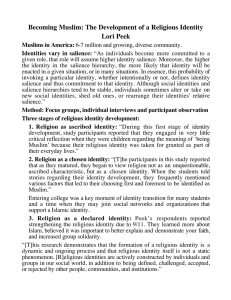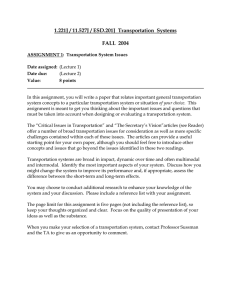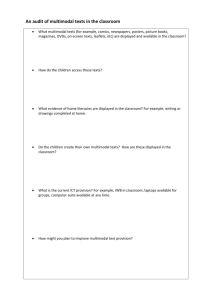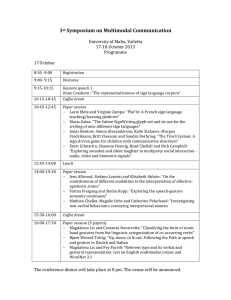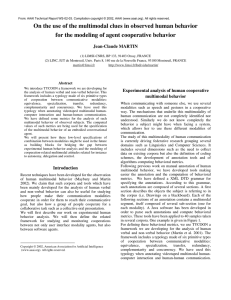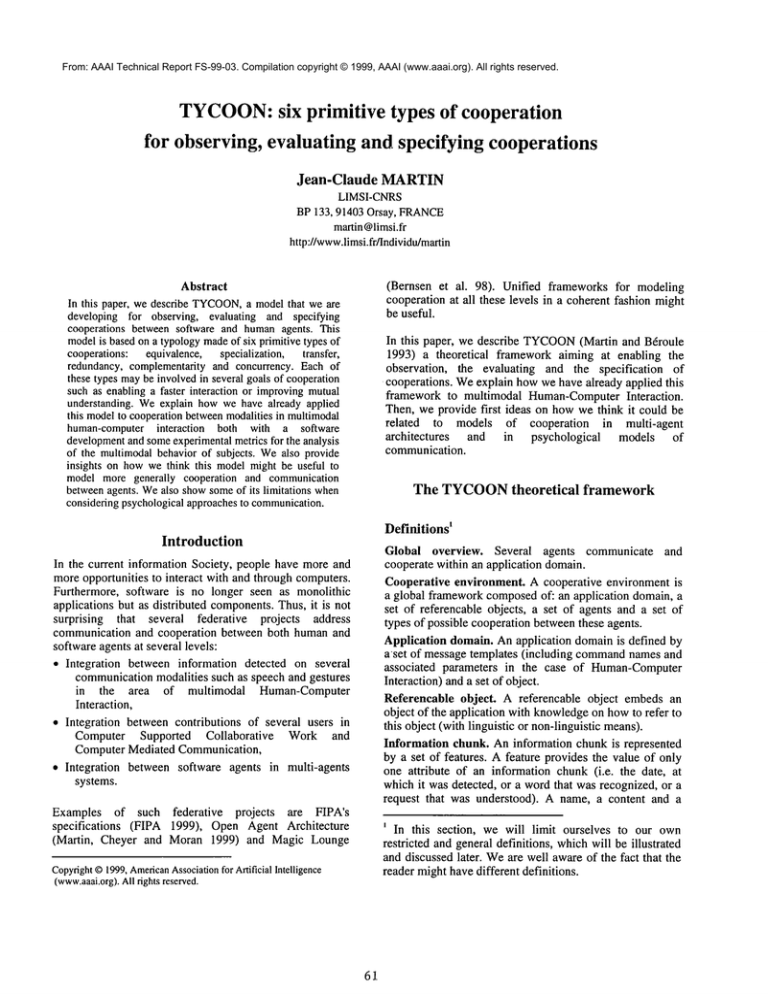
From: AAAI Technical Report FS-99-03. Compilation copyright © 1999, AAAI (www.aaai.org). All rights reserved.
TYCOON:
six primitive types of cooperation
for observing, evaluating and specifying cooperations
Jean-Claude
MARTIN
LIMSI-CNRS
BP 133, 91403 Orsay, FRANCE
martin@limsi.fr
http://www.limsi,
fr/Individu/martin
(Bernsen et al. 98). Unified frameworks for modeling
cooperation at all these levels in a coherent fashion might
be useful.
Abstract
In this paper, we describe TYCOON,
a modelthat we are
developing for observing, evaluating and specifying
cooperations between software and humanagents. This
modelis basedon a typologymadeof six primitive types of
cooperations: equivalence, specialization, transfer,
redundancy, complementarityand concurrency. Each of
these types maybe involvedin several goals of cooperation
such as enabling a faster interaction or improvingmutual
understanding. Weexplain howwe have already applied
this modelto cooperationbetweenmodalities in multimodal
human-computer interaction both with a software
development
and someexperimentalmetrics for the analysis
of the multimodalbehaviorof subjects. Wealso provide
insights on howwe think this modelmight be useful to
model more generally cooperation and communication
betweenagents. Wealso showsomeof its limitations when
consideringpsychologicalapproachesto communication.
In this paper, we describe TYCOON
(Martin and B6roule
1993) a theoretical framework aiming at enabling the
observation, the evaluating and the specification of
cooperations. Weexplain howwe have already applied this
framework to multimodal Human-ComputerInteraction.
Then, we provide first ideas on how we think it could be
related to models of cooperation in multi-agent
architectures
and in psychological
models of
communication.
The TYCOONtheoretical
framework
Definitions’
Introduction
Global overview. Several agents communicate and
cooperate within an application domain.
Cooperative environment. A cooperative environment is
a global frameworkcomposedof: an application domain, a
set of referencable objects, a set of agents and a set of
types of possible cooperation betweenthese agents.
Application domain. An application domainis defined by
aset of message templates (including commandnames and
associated parameters in the case of Human-Computer
Interaction) and a set of object.
Referencable object. A referencable object embeds an
object of the application with knowledgeon howto refer to
this object (with linguistic or non-linguistic means).
Information chunk. An information chunk is represented
by a set of features. A feature provides the value of only
one attribute of an information chunk (i.e. the date, at
which it was detected, or a wordthat was recognized, or a
request that was understood). A name, a content and
In the current information Society, people have more and
moreopportunities to interact with and through computers.
Furthermore, software is no longer seen as monolithic
applications but as distributed components.Thus, it is not
surprising that several federative projects address
communication and cooperation between both human and
software agents at several levels:
¯ Integration between information detected on several
communicationmodalities such as speech and gestures
in the area of multimodal Human-Computer
Interaction,
¯ Integration between contributions of several users in
Computer Supported Collaborative
Work and
Computer Mediated Communication,
¯ Integration between software agents in multi-agents
systems.
Examples of such federative
projects are FIPA’s
specifications
(FIPA 1999), Open Agent Architecture
(Martin, Cheyer and Moran 1999) and Magic Lounge
’ In this section, we will limit ourselves to our own
restricted and general definitions, whichwill be illustrated
and discussed later. Weare well awareof the fact that the
reader might havedifferent definitions.
Copyright
©1999,American
Association
for ArtificialIntelligence
(www.aaai.org).
Allrightsreserved.
61
confidencefactor define a feature.
Agent. An agent is a computational process represented
by: its name, a set of input information chunks it may
process, a set of output information chunks it mayproduce
and a confidence factor associated with this process. An
agent maybe humanor software.
Cooperation. A cooperation requires the exchange of
information in order to achieve a common
goal. In Tycoon,
we have distinguished six possible types cooperation
betweenagents (table 1).
A typology of types of cooperation
Equivalence. A cooperation by equivalence is defined by a
set of agents, a set of chunksof information, which can be
producedby either of the agents and a criterion, whichis
used to select one of the agents. Whenseveral agents
cooperate by equivalence, this means that a chunk of
information maybe producedas an alternative, by either of
them.
Transfer. A cooperation by transfer is defined by two
agents and a function mappingthe output of the first agent
into the input of the second agent. Whenseveral agents
cooperate by transfer, this means that a chunk of
information produced by one agent is used by another
agent.
Specialization. A cooperation by specialization is defined
by an agent, a set of agents A and a set of chunks of
information this agent is specialized in whencomparedto
the agents of the set A. When agents cooperate by
specialization,
this means that a specific kind of
information is always producedby the same agent.
Redundancy. Several agents, a set of chunks of
information and three functions define a cooperation by
redundancy. The first function checks that there are some
commonattributes in chunks produced by the agents, the
second function computes a new chunk out of them, and
the third function is used as a fusion criterion. If agents
cooperate by redundancy, this means that these agents
produce the same information.
Complementarity. A cooperation by complementarity is
defined similarly as a cooperation by redundancy except
that there are several non-common
attributes between the
chunks produced by the two processes. The commonvalue
of some attributes might be used to drive the fusion
process. Whenmodalities cooperate by complementarity,
different chunks of information are producedby each agent
and have to be merged.
Concurrency. A cooperation by concurrency means that
several agents produce independent chunks of information
at the same time. These chunks must not be merged.
Goals of cooperation. Several agents may exchange
information and cooperate for several reasons such as
enabling a fast interaction between agents or improving
mutualunderstanding of the agents.
Composingcooperations. In order to model sequence of
62
cooperations during interaction, each types of cooperation
can be composedwith other types of cooperation.
Limitations
Thesedefinitions do not include someclassical features of
agents and collaboration such as shared plan, intention,
interactive dialogue, beliefs, desire, and autonomy. The
reason is that in our work we wanted to focus on the
exchange of information as a required feature of
cooperation. Yet, we do not make any assumptions about
the linguistic
complexity of exchanged chunks of
information(i.e. lexical, semantic, or pragmatic).
co
o
Q
t~ e-
e~O
¢x:l
<
...
Equivalence
Transfer
Specialization
Redundancy
Complementarity
Concurrency
Table 1: The proposed typology for classifying exchanges
and cooperations. Six "types of cooperation" between
agents (lines) may be involved in several "goals
cooperation (columns).
Computational model
In order to process cooperation during communication,our
model involves a cooperation network (Martin and N6el
1998), which is a symbolico-connectionist model adapted
from Guided Propagation Networks (B6roule 1985).
cooperation network is made of interconnected processing
nodes (Figure 1). In order to cooperatewith other agents,
software agent requires such a cooperation network. The
next section will illustrate this cooperation networkmodel
in the case of the multimodal application that we have
developed.
Input nodes: an input node can be "activated" by an
external information chunk sent by other agents, whenit
becomes activated,
it sends a symbolic structure
representing the detected information chunks to one or
several cooperation nodes.
Cooperationnodes: a cooperation node can be activated
by one or several such symbolic structures representing
hypotheses sent either by input nodes or by other
cooperation nodes. The topology of such a network as well
as the behavior of each cooperation node has to be
specified for each new agent willing to integrate
cooperations from other agents.
Terminal nodes: the activation of a terminal node
represents the recognition of a message template and
triggers a reference resolution process before executing an
associated command
by the agent.
Salience value: the reference resolution process is based
on the computation of salience values such as in (Huls,
Claassen and Bos 95). The salience value of a referencable
object in a chunk of information gives an idea of how
muchthis object is explicitly referred to in this chunk. A
global salience value is computed across several
information chunks in order to find the best candidate for
the reference resolution. In case of ambiguity, two
referencable objects mayhave the same salience in the
same chunk of information. Yet, this ambiguity might be
removedwhenconsidering the salience of these objects in
other chunks of information.
Parse
the specification
file.
Create
the cooperation
network.
Create
the set of referencable
While
not exit
// Process
incoming
IF (information
objects.
information
chunk
has been received)
THEN
Update
salience
Create
an information
Put it into
node
FOR each
Test
this
node
node,
of the
between
nodes
node
in the network
should
be activated
on the type
and
information
information.
information
depends
objects.
object.
output
this
cooperation
if this
(this
the
managing
// Propagate
of referencable
of cooperation
on the output
of
of its input
nodes).
IF this
node
THEN
Build
a new hypothesis
Compute
In
hypothesis
node
Solve
\"~k
object.
object
into
the
of this node.
IF this
THEN
Cooperation
Nodes
to be activated
its score.
Put this
output
needs
is terminal
references
and
execute
command
Table 2: Algorithmof propagation in the network.
Terminal Nodes
Application
Figure 1: A simple example of a cooperation network.
Input nodes (squares) are connected to cooperation nodes
(circles). Each cooperation node can be of six type:
Equivalence (E), Redundancy(R), Complementarity
Specialization (S), Transfer (T). Concurrency(//).
to Multimodal Interfaces
Software implementation
In the case of the multimodal application, two modality
agents (a speech recogniser and a module processing
simple 2D pointing gestures) cooperate with a multimodal
agent. This multimodal agent makes use of a cooperation
network and a file specifying cooperations betweenspeech
and gestures (table 3). Whenevents are detected
modalities, hypotheses on the detected cooperation
between modalities propagate in the network. The salience
of the referencable objects is also updated as a function of
the detected events. For instance, the recognition of the
word "hotel" by the speech recognizer will increase the
salience of all the displayed hotels. Table 4 provides the
informal definition of someheuristic rules for updating the
salience of referencable objects. After several propagation
steps, when a commandis recognized, the most salient
object is selected as a candidate for parameter’s value, and
the commandis executed. Multimodal recognition scores
are computed as a weighted sum of modality confidence
factors and the score of events (such as the one provided
by the speech recognizer).
Fusion criteria: three fusion criteria can be used for
complementarity: time coincidence (the chunks of
information are produced within the same temporal
window),temporal sequence, and structural completion(all
specified chunks have been detected).
A command language
for specifying
types of
cooperation: instead of hard-coding the cooperations
betweenagents in our software for a specific application,
we have developed a commandlanguage for specifying
cooperations betweenagents.
Algorithm: the algorithm for processing chunks of
information coming from other agents is provided in
table 2.
63
Analyzing the multimodal behavior of subjects
Several user studies have been done by researchers to
analyze the multimodal behavior of subjects when
interacting with simulated or implemented multimodal
systems; see (Martin, Julia and Cheyer1998) for a survey
of multimodal user studies. Wehave applied the TYCOON
model to the analysis of the multimodal behavior of
subjects in a Wizard of Oz experiment at the Stanford
Research Institute (Cheyer, Julia and Martin 1998). During
this experiment, subjects were asked to interact with a
simulated system using speech and pen. Sessions were
videotaped. During the analysis of the video corpus,
salience of the reference to objects was computedsimilarly
to the rules describedin table 4.
// A variable V3 is defined as the beginningof a
//sequence
start_sequence V3
//V3 may be activated by one event amongseveral
equivalence V3
Speech what is the name_of
Speech what is that
//This V3 variable is linked sequentially to
// a secondvariable V4
complementarity_sequence
V3 V4
//V4 may only be activated by a gesture event
specialization V4Gesture *
The rate at which a subject makesuse of equivalence (i.e.
switches between several modalities for the same
command)is computed with the following formula: the
numberof commandsCj expressed via different modalities
is divided by the total numberof commandsexpressed by
the subject during the experiment.
//V4 is boundto a parameter of an application module
//which is involved in the execution process
bind_application Parameter 1NameOfV4
Table 3: Exampleof the specification of a command
in the
multimodalmapapplication. This specification enables the
cooperation betweenspeech and gesture in order to get the
nameof an object of the map(hotel, museum...).
Speech
Z equivalence -
I{Cj /equivalent( Cj)
:lcJ
I
cj
The rate at whichthe subject’s behavioris either redundant
or complementaryis computedwith the following formula:
a global salience value is computedover all referents rk of
all the commandsCj expressed by the subject; then this
numberis divided by the numberof referents expressed by
the subject during the experiment.
]~ ~ salience(Cj, rk)
"C compl.I redund.= Cj rk~ R(Cj)
Z
cj
If the recognized sentence contains the
unique name of an object (i.e. "the Orsay
museum"),set the salience of this object in
the speech modality to the score provided
by the speech recogniser.
Ie(cJ)l
If the recognizedsentence contains only the
value of a property of an object (i.e. "the
museum"), increase the salience in the
speech modality of all referencable object
having the sameproperty value (i.e. all the
museums) taking into account the score
provided by the speech recogniser.
Set the salience in the gesture modalityas a
Gesture function of the distance between the
location of the object and the focus point of
the recognizedgesture.
Set the salience in the graphics modality as
Graphics a function of the distance between the
location of the object and the center of the
screen.
After the recognition of a command,the
History salience of objects referred to in this
command is decreased by a forgetting
factor.
Table 4: Informal definition of someof the rules used for
updating the salience of objects whenan event is detected
on a modality.
Someresults of the computation of such statistics
describedin (Kehler et al. 98).
are
Discussion
Multi-agent Communication
Our frameworkis focussing on the way an agent integrates
messages coming from several other agents. Multi-agent
software architectures often feature a so-called facilitator
agent brokering the messages emitted by agents thanks to
services declared by these agents. Within our model,
several agents ai maycooperate according to several types
of cooperation to process a message m received by the
facilitator (Figure2):
* equivalence: each agent ai can process the message m
but with different response time or confidence which
will lead the facilitator to send the messageto only one
of these agents,
64
¯
redundancy: each agent ai can process the message m
but with different response time or confidence which
will lead the facilitator to send the samemessagem to
all the agents a,, to wait for the results and to merge
them,
¯ complementarity: each agent al can process only part of
the messagem which will lead the facilitator to send
parts of the messagem to all agents, to wait for the
results and to mergethem,
¯ specialization: the facilitator will send the messagemto
the only agent whocan process it.
(2)
~
ethnomethodological approach which try to do without
plan. Cooperation requires communication in order to
exchangeinformation, to showto others our intention, to
interpret and understand the others intentions in terms of
present and future actions. Communicationalso requires
cooperation
in order to ensure the success of
communicative acts. In the case of human-human
communication, our frameworkcan be used for analyzing
the way someone integrates
knowledge coming from
several people. Whenconsidering communicationbetween
only two people, it could be also used to analyze the way
linguistic and non-linguistic signals (facial expression,
gesture, and shared awarenessof actions) are produced.
Herbert Clark considers language use as a form of joint
action (Clark 1996). As a joint activity, a conversation
consists of a joint action and the individual actions by the
conversationalparticipants that constitute the joint action.
Webelieve that the types of cooperation that we have
proposed could be useful to analyze the cooperations
between these individual
actions that make up a
conversation. Individual actions could be observed to
cooperate by equivalence, redundancy...in the building of
the joint conversation.
eFacilitator
~)
(4)
Figure 2: Suggestions on how the types of cooperation
could be used by a facilitator agent in the case of multiagent architecture:
1. Anagent Ai sends a messageto the facilitator agent
2. Consideringthe services declared by a set of agents
{Aj}, the facilitator selects one or several agents Aj
as well as the type of their cooperation.
builds some messages and sends
3. The facilitator
themto the selected agents Aj.
4. Oneor several agents report to the facilitator
5. In the case of redundancy and complementarity
these messagesare integrated.
6. Thefacilitator sends a reply to the agent Ai.
TYCOONcould also be used for observing
the
cooperations between agents and modifying the selection
strategy used by the facilitator in the light of the real
behavior of agents compared to the services they have
declared.
Psychological Models of Communication
Notions like equivalence, transfer, specialization,
redundancy are often mentioned in psychological and
neurobiological studies of multi-sensory fusion processes
(Hatwell 1994, Stein and Meredith 1993, Hartline 1985).
Yet we have not found them grouped into a coherent
typology of types of information exchangeor cooperation
as the one we suggest.
(Decortis and Pavard 1994) consider several approaches
the study of communicationand cooperation: those based
on communicativeacts, the cognitive approach willing to
integrate the inferential nature of communicationand the
65
(Grosz and Sidner 1986) proposed a theory of discourse
structure comprising three components dealing with
different aspects of the utterances in a discourse: a
linguistic structure, an intentional structure and an
attentional state. The basic elements of the linguistic
structure are the utterances. The intentions and the
relations of dominationand satisfaction precedenceare the
basic elements of the intentional structure. Finally, the
attentional state contains information about the objects,
properties, relations and discourse intentions that are most
salient at any given point. What we call referencable
objects are related to such an attentional state component.
Yet, our approach does not deal with the linguistic and
intentional components.
Conclusion
In this paper we have presented a modelmadeof six types
of cooperation and a cooperation network. Wedescribed
how we applied it to multimodal human-computer
interaction. In the future, we wouldlike to study howour
types of cooperation could be used to model cooperation
between actions of the agents having a shared plan (i.e.
cooperation by complementarity between two actions
could be used to achieve part of a plan).
Martin, D.L.; Cheyer, A.J. and Moran, D. B. 1999. The
open agent architecture:
A framework for building
distributed software systems. AppliedArtificial Intelligence
13:91-128
References
Bernsen, N.O.; Rist, T.; Martin, J.C.; Boullier, D.;
Briffault,
X.; Dybkjaer, L.; Hauck, C.; Henry, C.;
Masoodian, M.; Nrel, F.; Profitlich, H.J.; Andrr, E.;
Schweitzer, J.; Vapillon, J. 1998. Magic Lounge: A
Thematic Inhabited Information Space with "Intelligent"
Communication Services. La Lettre de l’Intelligence
Artificielle, May1998.
Martin, J.C. and Brroule, D. 1993. Types et Buts de
Coopdration entre Modalitrs In Actes des cinqui~mes
journdes sur l’ingdnierie des Interfaces Homme-Machine
(IHM’93),19-20 octobre, Lyon, France.
Martin, J.C. and Ndel, F. 1998. Speech and gesture
interaction for graphical representations: theoretical and
software issues. In Proceedings of the Workshop on
"Combining AI and Graphics for the Interface of the
Future", European Conference on Artificial Intelligence
(ECAI’98). August 24, Brighton.
Brroule, D. 1985. Un ModUle de Mrmoire Adaptative,
Dynamiqueet Associative pour le Traitement Automatique
de la Parole. Ph.D. diss., Limsi-CNRS,
OrsayUniversity.
Cheyer, A.; Julia, L. and Martin, J.C. 1998. A Unified
Frameworkfor Constructing Multimodal Experiments and
Applications. In Proceedings of the Second International
Conference on Cooperative Multimodal Communication,
Theory and Applications (CMC’98),28-30 January 1998,
Tilburg, The Netherlands
Martin, J.C.; Julia, L. and Cheyer, A. 1998. A Theoretical
Frameworkfor Multimodal User Studies. In Proceedings
of the Second International Conference on Cooperative
Multimodal Communication, Theory and Applications
(CMC’98),28-30 January 1998, Tilburg, The Netherlands.
Clark, H.H. 1996. Using Language. CambridgeUniversity
Press.
Stein, B.E. and Meredith, M.A. 1993. The merging of the
senses. Cognitive Neuroscience series. A Bradford book.
MITPress.
Decortis, F. and Pavard, B. 1994. Communication et
cooprration : de la throrie des actes de langage
l’approche ethnomdthodologique.In Systbmes coop~ratifs :
de la moddlisation gl la conception. Bernard Pavard (Ed.)
ISBN2-906769-18-5.
Acknowledgments
The author wishes to thank at Limsi: F. Nrel and J.
Vapillon; and at SRI: J. Hobbs, A. Kehler, A. Cheyer, L.
Julia and J.Bear.
FIPA1999. http://www.fipa.org/
Grosz, B. J. and Sidner, C. L. 1986. Attention, intentions,
and the structure of discourse. ComputationalLinguistics
12(3):175-204.
Hartline P. H. 1985. Multimodalintegration in the brain.
Combiningdissimilar views of the world. In M.J. Cohen
(ed.), Comparativeneurobiology: modes of communication
in the nervous system, chap. 18, 309-334, John Wiley and
Sons.
Hatwell, Y 1994. Transferts intermodaux et intrgration
intermodale. In Trait6 de Psychologie Exp#rimentale,
(eds.) M. Richelle, J. Requin&M. Robert. Paris : Presses
Universitaires de France.
Huls, C.; Claassen, W. and Bos, E. 1995. Automatic
Referent Resolution of Deictic and AnaphoricExpressions.
ComputationalLinguistics 21 (1):59-79.
Kehler, A.; Martin, J.C.; Cheyer, A.; Julia, L.; Hobbs,J.
and Bear, J. 1998. On Representing Salience and
Reference in Multimodal Human-Computer
Interaction In
Proceedings of the AAAI’98Workshopon Representations
for Multi-modal Human-Computer
Interaction. July 26-27,
1998, Madison, Wisconsin.
66

